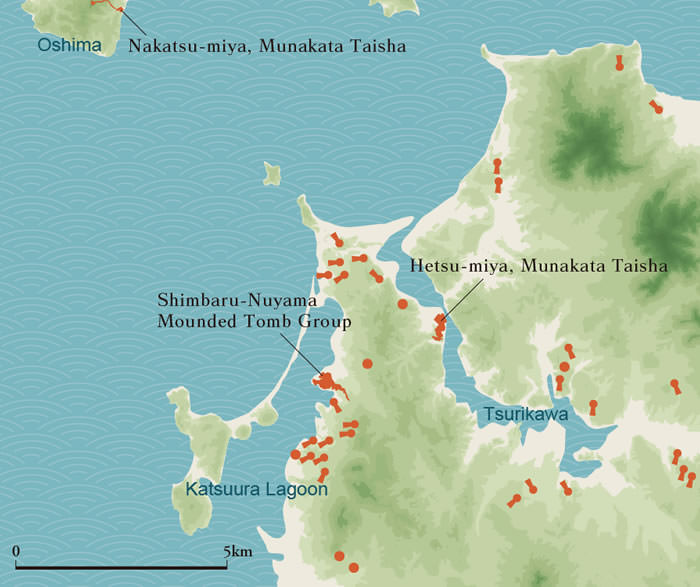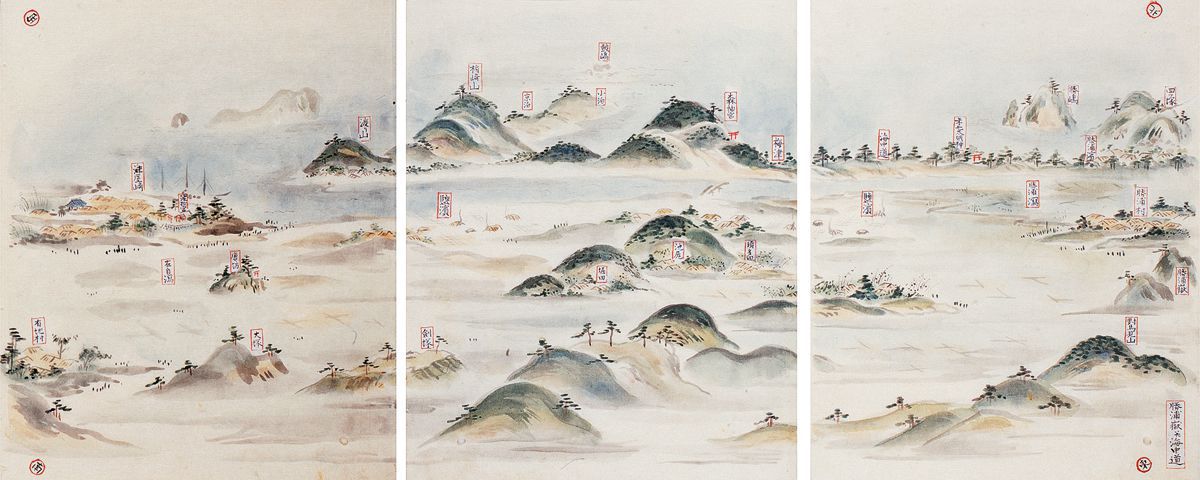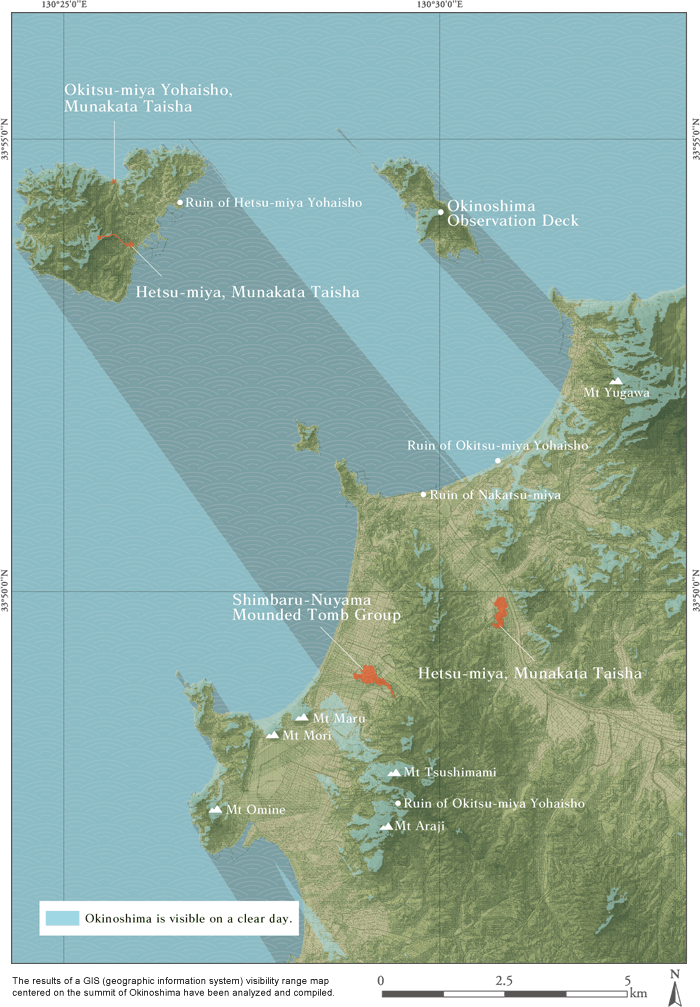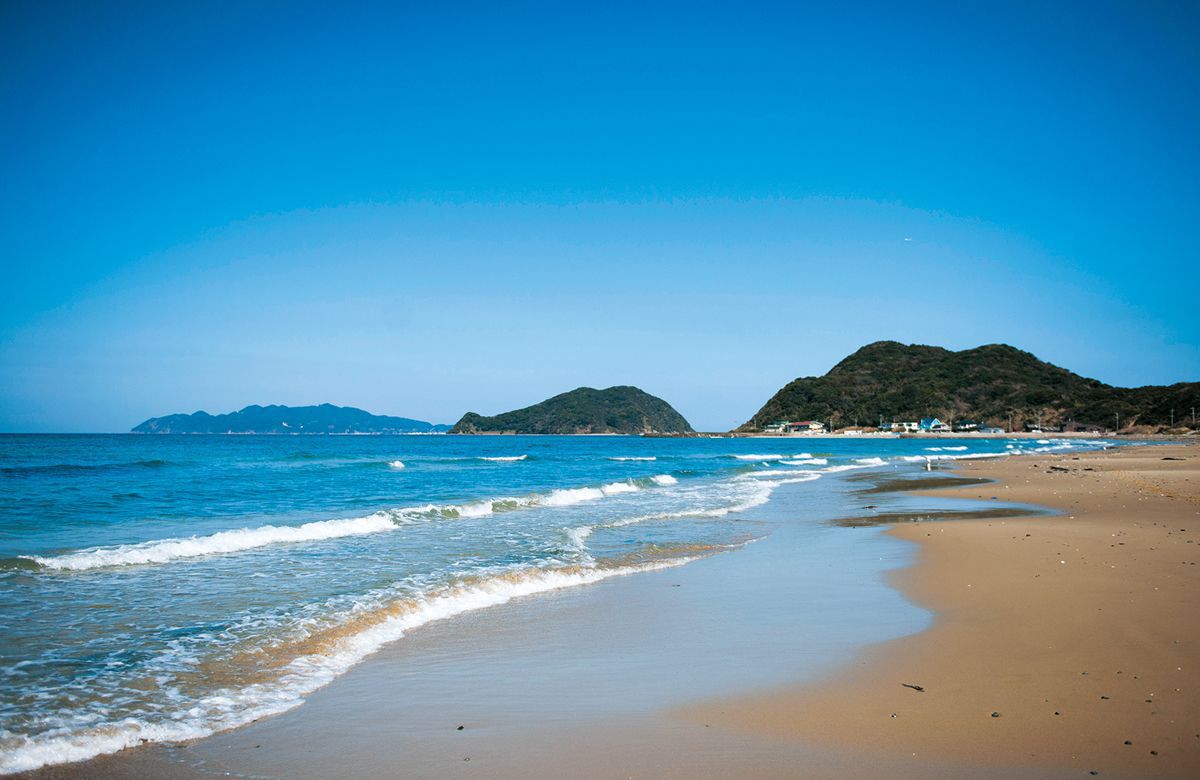That ordinary-looking landscape tells a hidden story of the history and meaning of this property.
A sea inlet
Hetsu-miya and the sea inlet
The Tsurikawa River flows through Munakata City, and the Katsuura Lagoon that opens out in Fukutsu City was once a sea inlet.
Various tributaries flowing down from the mountains join together to form the Tsurikawa River, which then flows into the Genkai Sea. It has been an important water source for the Munakata region since ancient times. People have always lived near the river and it has been a central part of their lives.
The Tsurikawa River flowing into the sea is described in the Nihonshoki, written with the characters for "seaside" that actually indicated "Hetsu-miya." During the medieval period, at Munakata Taisha there were many Shinto rituals that focused on the sea and river. In the Funakurabe (Sea Battle) Ritual in the Hojo-e ceremony,, the Munakata fishing villages of Kanezaki, Konominato, Katsuurahama, and Tsuyazaki make offerings to a sacred boat said to be carrying the deities, which are then placed on a portable shrine and raced in a boat race on the Tsurikawa River.

The mounded tomb group and the sea inlet
The sea inlet was reclaimed by means of drainage, part became a salt flat, and part was newly developed as rice fields.
The rural landscape today has been built up by generations of local farm families working and maintaining the land year after year, with local residents cutting the grass and performing other maintenance work.
When the former sea inlet stopped functioning as one, its appearance changed to that of a rice paddy; but the rural landscape that spreads out like a great ocean calls to mind the landscape in ancient times, when ships often passed through this area.

Edo-period landscape with Katsuura Lagoon. A picturesque landscape of a "sea path" of coastal sandbanks leading into pine groves. On the reclaimed land, smoke rises from cooking by means of salt broiling, and sailing ships gather in Tsuyazaki Harbor, which is connected to the open sea. There are some place names derived from burial mounds, such as Otsuka and Tsurugizuka on hills as well as farm villages with traditional houses with thatched roofs.
Remote worship
Access to Okinoshima is limited by strict taboos. Therefore, Okitsu-miya Yohaisho was established on Oshima, an island that is separated from Okinoshima by the sea.
As the name "Yohaisho" suggests, it serves as a place from which to worship the sacred island of Okinoshima from afar. Its shrine building functions as a worship hall for Okinoshima.

During the Edo period, structures existed on Eguchi Beach on the main island of Kyushu to worship both Okitsu-miya and Nakatsu-miya from afar. The feudal lord of Fukuoka visited Hetsu-miya when he conducted an inspection of the territory, and at that time he paid homage to both shrines.
Records show that places to worship Okitsu-miya from afar had been established in the low-lying areas near Fukuoka Castle, on Mt Aratsu (Nishi-koen, Fukuoka City), and in Uomachi (in the vicinity of Akasaka, Fukuoka City).
The people of the Munakata region have long worshipped Okinoshima from afar in daily life to pray for safe ocean voyages, a plentiful fishing catch, abundant crops, and household peace and prosperity.
At one time there was a custom called "Okinoshima retreat (Okinoshima Gomori)". In the summer, when the rice planting was done, people would seclude themselves at a beach or mountain plateau from which they had a view of Okinoshima, make offerings of sacred sake and red bean rice, and give thanks that the rice planting had been safely concluded. They would also pray for good health as they worshipped Okinoshima from afar.
The people of the Munakata region feel the presence of deity in the natural landscape, and have taken great care to preserve their faith in Okinoshima and the Three Female Deities of Munakata.
A spiritual landscape
Gifts of the sea
To the coastline of the Munakata region, which is described as the "edge of an opened parasol", much debris are washed up on shore due to the effects of ocean currents and wind.
The season for gathering driftwood and pieces of flotsam is winter. Northwesterly seasonal winds from the continent make for rough seas, and due to the effects of the Japan Current and Tsushima Current, many objects are strewn across the beach.
Objects washed up on shore tell many stories. The Genkai Sea, due to its rough waves and rapidly moving currents, is famed as a perilous stretch for boats to pass through.
Since ancient times, freight and debris have been washed ashore from shipwrecked vessels along the Munakata coast. Things collected there were looked upon as sacred objects, and were used to help offset the cost of repairs on subordinate shrines of Munakata Taisha. The imperial court at that time formally recognized the privilege, and that area of the sea was governed by Munakata Taisha as a sacred precinct.
In recent years, however, plastic bags and containers, styrofoam and other garbage has also been carried ashore by the currents. Some pine groves exhibit conspicuous damage from beetles that feed on pine trees.
The local people want to leave a beautiful shoreline for future generations, and with that thought in mind, neighborhood associations and volunteer organizations, schools, businesses and other groups are engaging in conservation activities such as coastal cleanup projects, planting pine seedlings, and other works.
Thanks to their devoted efforts, a beautiful coastline worthy of its classic description as "white sand and green pines" is being preserved.

The sacred Munakata district
In the mythology of the Kojiki and Nihonshoki, the Three Female Deities of Munakata are said to govern the northern sea route, or in other words, the passage leading from the Munakata region to the Korean peninsula.
The Munakata region (Munakata City and Fukutsu City) was once called the Munakata district (gun), and historically it was considered as a single geographical entity.
In the ancient ritsuryo legal system, some local districts where especially important shrines for the state were located were called "sacred districts" (shingun). Munakata was designated as one of these eight sacred districts.
In the Munakata region, each community had its tutelary deity, hence the existence of many subordinate shrines affiliated with Munakata Taisha. During the medieval period, there were 75 subordinate shrines within the Munakata district.In the Munakata region, many shrine parishioners were affiliated with both Munakata Taisha and their village shrines (tutelary deities). They kept the shrine precincts clean and participated in rituals. Within daily life they continue their work to preserve the shrines with great attentiveness and care.


